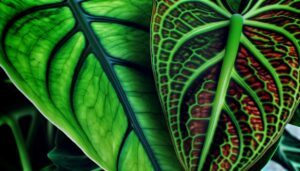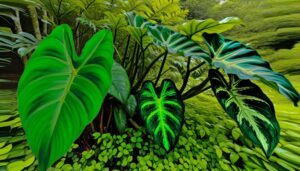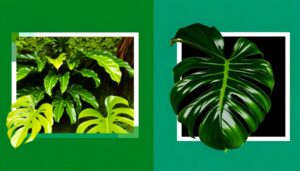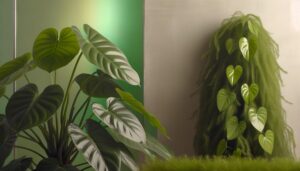Philodendron Cream Splash Vs Brasil: Visual Showdown!
Philodendron Cream Splash and Philodendron Brasil are tropical plants from the Araceae family, endemic to Central and South America’s rainforests. Cream Splash features heart-shaped leaves with creamy white variegation and a more slender, pointed apex, while Brasil boasts broader, ovate leaves with a yellow-green central stripe.
Both exhibit a vining growth habit and require support structures, though Brasil is faster-growing and more tolerant of lower light conditions. Ideal soil includes perlite, peat moss, bark chips, and activated charcoal for moisture retention.
Each plant has unique propagation and pest management needs. Continue further to explore their specific light and soil preferences in detail.
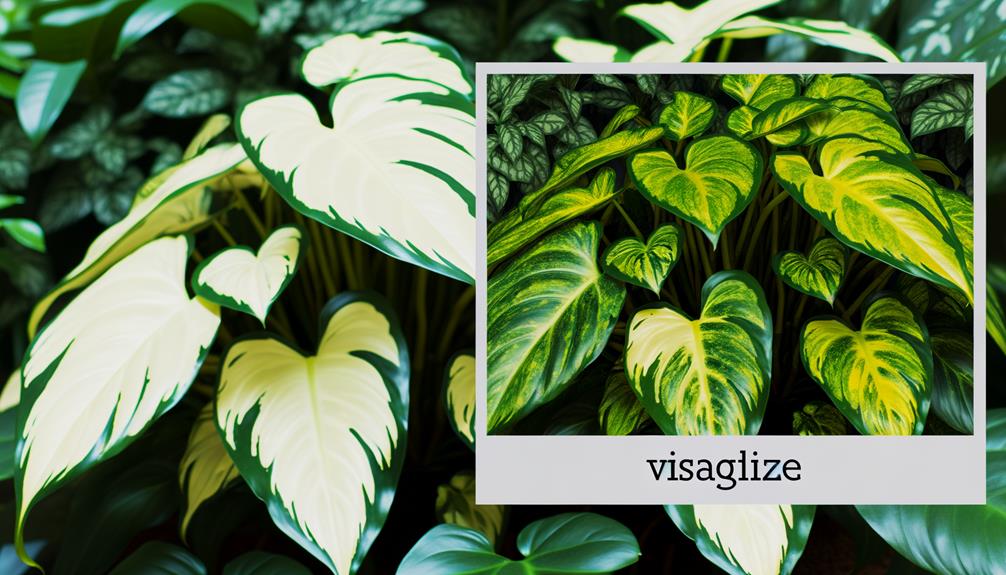
Comparison of Philodendron Cream Splash and Philodendron Brasil
| Feature | Philodendron Cream Splash | Philodendron Brasil |
|---|---|---|
| Scientific Name | Philodendron hederaceum var. ‘Cream Splash’ | Philodendron hederaceum var. ‘Brasil’ |
| Leaf Texture | Smooth, glossy | Thick, waxy |
| Leaf Color | Dark green with prominent cream/light green variegation | Dark green with yellow/light green variegation |
| Variegation Pattern | Cream or light green stripes down the center | Irregular yellow/green splashes |
| Leaf Shape | Heart-shaped, more pronounced variegation | Heart-shaped, less pronounced variegation |
| Growth Habit | Climbing/trailing | Climbing/trailing |
| Rarity | Generally rarer | More commonly available |
| Light Preference | Prefers bright, indirect light | Prefers bright, indirect light |
| Care Requirements | Moderate humidity, regular watering | Moderate humidity, regular watering |
Origins and Background
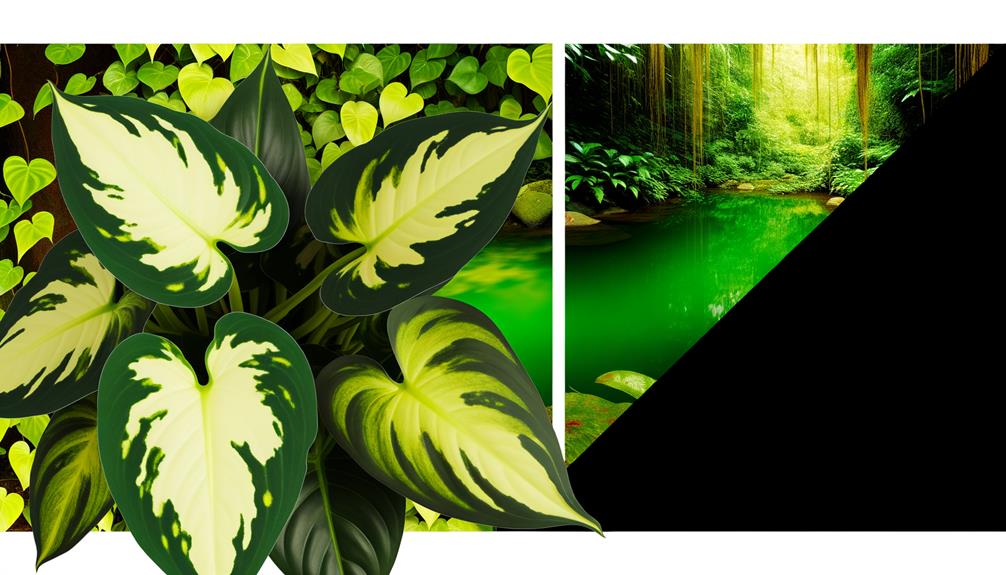
Both the Philodendron Cream Splash and Philodendron Brasil belong to the diverse and scientifically significant Araceae family, originating from the tropical rainforests of Central and South America. These species thrive in humid, shaded environments, indicative of their native habitats.
The Philodendron genus is renowned for its adaptability and robust nature, making these plants popular in both horticultural and interior design applications. The Cream Splash is notable for its variegated foliage, featuring cream and green hues, while the Brasil showcases striking yellow and green patterns.
The botanical background of these plants underscores their evolutionary adaptations, such as epiphytic growth habits, enabling them to secure nutrients and moisture from the air, an essential survival strategy in their densely vegetated, competitive ecosystems.
Leaf Shape and Size
The Philodendron Cream Splash exhibits elongated, heart-shaped leaves with creamy variegation, whereas the Philodendron Brasil‘s foliage is characterized by a more rounded, heart-shaped contour with prominent yellow variegation.
The Cream Splash’s leaves typically measure between 10 to 15 centimeters in length, displaying a more slender, pointed apex. In contrast, the Philodendron Brasil’s leaves, while similar in length, exhibit a broader, more ovate structure with a less pronounced apex.
Both species possess a similar petiole structure, enhancing their climbing capabilities. The variance in leaf shape and size between these two philodendrons contributes to their distinct visual appeal, making them unique specimens for botanical enthusiasts and collectors alike.
Detailed observation of these morphological traits can aid in accurate identification and cultivation practices.
Color and Variegation
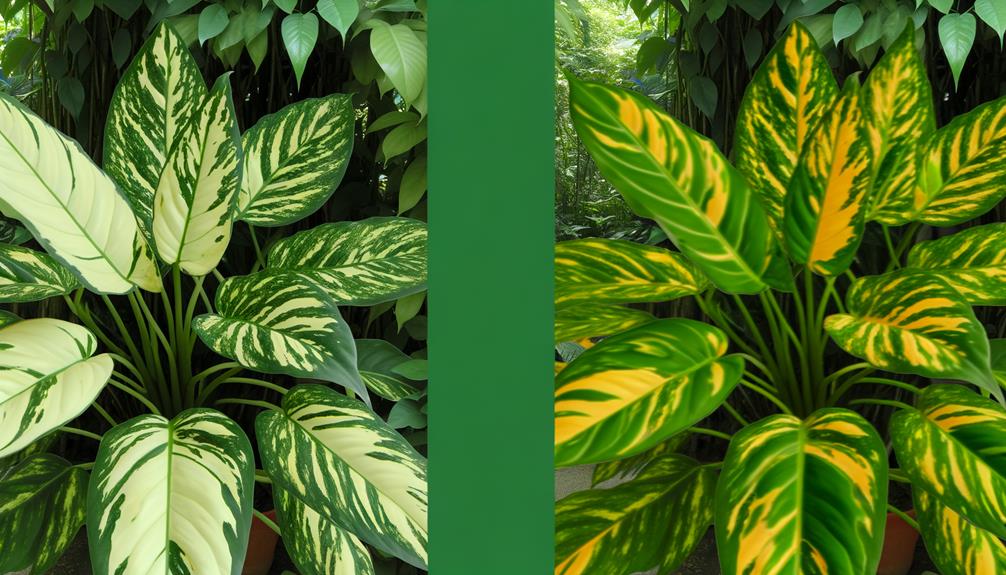
Exhibiting a mesmerizing array of hues, Philodendron Cream Splash and Philodendron Brasil each present distinct variegation patterns that are instrumental in their identification and aesthetic appeal.
Philodendron Cream Splash features leaves with a unique combination of dark green and creamy white sections, often displaying an irregular distribution of color. This variegation results in a striking contrast, contributing to its ornamental value.
In comparison, Philodendron Brasil showcases a vivid palette of bright green leaves adorned with a central stripe of yellow-green variegation. This stripe typically runs along the midrib, creating a symmetrical and eye-catching pattern.
Both varieties leverage their distinct variegation to enhance visual interest, making them highly sought after by plant enthusiasts and collectors.
Growth Habits
Understanding the growth habits of Philodendron Cream Splash and Philodendron Brasil is essential for enhancing their care and ensuring their healthy development. These two popular Philodendron varieties display distinct growth patterns that influence cultivation practices.
- Vining Nature: Both varieties exhibit a vining growth habit, requiring support structures like trellises or moss poles.
- Growth Rate: Philodendron Brasil typically grows faster than Cream Splash, making it more suitable for rapid space filling.
- Stem Thickness: Brasil tends to develop thicker stems compared to the more delicate Cream Splash.
- Leaf Size: Brasil often has larger leaves, contributing to its more robust appearance.
- Propagation: Both varieties can be easily propagated through stem cuttings, ensuring quick multiplication of plants.
Understanding these traits helps in tailoring care routines for enhancing plant health.
Light Requirements

Although both Philodendron Cream Splash and Philodendron Brasil thrive in bright, indirect light, their specific light requirements slightly differ to maximize growth and variegation. Philodendron Cream Splash prefers a higher intensity of indirect light to maintain its striking variegation.
Inadequate light may cause the cream-colored sections to revert to green. On the other hand, Philodendron Brasil is more tolerant of lower light conditions, but ideal variegation is achieved with moderate, filtered light.
| Aspect | Philodendron Cream Splash | Philodendron Brasil |
|---|---|---|
| Preferred Light | Bright, indirect | Bright, indirect |
| Light Tolerance | Medium to high | Low to medium |
| Impact of Low Light | Variegation loss | Reduced growth rate |
| Optimal Light Hours | 8-10 hours | 6-8 hours |
| Direct Sun Exposure | Avoid | Avoid |
Understanding these nuances guarantees both plants exhibit their best foliage and growth.
Watering Needs
Philodendron Cream Splash and Philodendron Brasil exhibit differing watering needs, primarily influenced by their best moisture levels, watering frequency, and soil drainage requirements.
The Cream Splash prefers consistently moist soil, necessitating more frequent watering, whereas the Brasil can tolerate slight dryness between waterings.
Both species require well-draining soil to prevent root rot, underscoring the importance of proper substrate selection.
Optimal Moisture Levels
Maintaining ideal moisture levels is essential for the healthy growth of both the Philodendron Cream Splash and the Philodendron Brasil, as these plants thrive in consistently moist but not saturated soil. It is critical for enthusiasts to understand that the balance of moisture is a key determinant of plant health.
Overwatering can lead to root rot, while underwatering can cause dehydration and stress.
Key considerations for best moisture levels include:
- Soil Type: Use well-draining, aerated soil to prevent waterlogging.
- Container Choice: Make sure pots have sufficient drainage holes.
- Humidity: Maintain ambient humidity levels between 40%-60%.
- Water Quality: Use filtered or rainwater to avoid mineral buildup.
- Mulching: Apply mulch to retain soil moisture and regulate temperature.
These guidelines ensure prime health and growth.
Watering Frequency Differences
Understanding the specific watering needs of Philodendron Cream Splash and Philodendron Brasil is essential to ensuring their best growth and avoiding common issues such as root rot or dehydration.
Both species thrive in a consistently moist environment; however, their watering frequency can vary slightly. Philodendron Cream Splash typically requires watering when the top inch of soil feels dry to the touch, approximately every 7-10 days.
Conversely, Philodendron Brasil is slightly more drought-tolerant and may need watering every 10-14 days, depending on environmental conditions such as humidity and temperature.
It is vital to monitor the soil moisture regularly and adjust the watering schedule accordingly to maintain an ideal balance, preventing both overwatering and underwatering.
Soil Drainage Requirements
Why is proper soil drainage vital for maximizing the watering needs of both Philodendron Cream Splash and Philodendron Brasil? Effective soil drainage guarantees that the roots receive sufficient oxygen while preventing waterlogging, which can lead to root rot and other fungal infections. Both species flourish in well-draining soil that balances moisture retention and aeration.
To achieve peak soil drainage:
- Use a potting mix containing perlite or orchid bark.
- Ensure the pot has drainage holes.
- Incorporate organic matter like peat moss.
- Avoid excessively compacting the soil.
- Monitor the moisture level regularly with a soil moisture meter.
Soil Preferences

Both Philodendron Cream Splash and Philodendron Brasil flourish in well-draining soil with a high organic matter content. Best soil composition should include a combination of peat, perlite, and orchid bark to guarantee proper aeration and nutrient availability.
Additionally, these species need soil that retains sufficient moisture without becoming waterlogged to avoid root rot.
Optimal Soil Composition
The best soil composition for Philodendron Cream Splash and Philodendron Brasil requires a well-draining mix that retains enough moisture without becoming waterlogged. This balance is essential for promoting healthy root development and preventing root rot. An ideal soil mix includes components that enhance aeration and nutrient availability.
Key ingredients to ponder include:
- Perlite: Enhances aeration and drainage.
- Peat Moss: Retains moisture and provides slight acidity.
- Bark Chips: Improves drainage and structure.
- Coco Coir: Retains moisture while remaining airy.
- Activated Charcoal: Assists in removing impurities and toxins.
These elements collectively create an ideal growing medium, ensuring that the philodendrons receive sufficient water and nutrients while preventing root health issues.
Moisture Retention Needs
Understanding the moisture retention needs of Philodendron Cream Splash and Philodendron Brasil is crucial to selecting the suitable soil preferences for these houseplants.
Both species thrive in well-draining soil mixes that maintain adequate moisture without becoming waterlogged. A balanced mix of peat, perlite, and pine bark is recommended to provide the necessary aeration and moisture preservation.
The table below details the ideal soil composition for each plant.
| Soil Component | Philodendron Cream Splash | Philodendron Brasil |
|---|---|---|
| Peat | 40% | 40% |
| Perlite | 30% | 30% |
| Pine Bark | 20% | 20% |
| Additional Mix | 10% (Coconut Coir) | 10% (Compost) |
This composition ensures optimal moisture retention, promoting healthy root systems and robust growth.
Propagation Methods
Propagating Philodendron Cream Splash and Brasil involves meticulous techniques that secure healthy growth and successful establishment of new plants. Both varieties can be propagated through stem cuttings, utilizing either water or soil as the medium.
Key steps include:
- Selecting a healthy parent plant: Choose a plant free from stress and disease.
- Cutting below a node: Guarantee the cutting has at least one node and a few leaves.
- Rooting in water: Place the cutting in water, changing it weekly to prevent stagnation.
- Rooting in soil: Insert the cutting into moist, well-draining soil.
- Maintaining humidity: Cover with a plastic bag to retain moisture until roots develop.
These steps secure robust root systems and thriving new plants.
Common Pests and Diseases
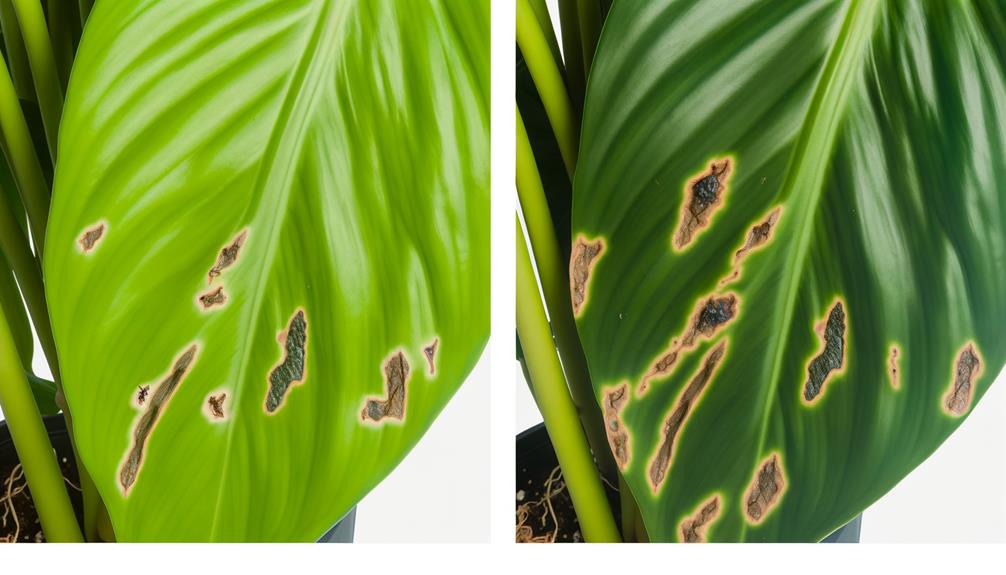
Philodendron Cream Splash and Brasil are susceptible to various common pests such as spider mites, aphids, and mealybugs, which can cause significant damage if not managed promptly.
Additionally, these plants are prone to fungal infections like root rot and leaf spot, often exacerbated by overwatering or poor ventilation.
Effective treatment methods include the application of appropriate insecticides, fungicides, and implementing proper cultural practices to prevent recurrence.
Insect Infestations
Insect infestations, particularly from pests such as spider mites, aphids, and mealybugs, pose significant threats to both Philodendron Cream Splash and Brasil. These pests disrupt the plant’s ability to photosynthesize and absorb nutrients effectively, often leading to symptoms like yellowing leaves, stunted growth, and overall plant decline.
Key signs of infestation include:
- Spider Mites: Fine webbing on the undersides of leaves.
- Aphids: Sticky residue (honeydew) and curled leaves.
- Mealybugs: Cotton-like masses on stems and leaf nodes.
- Thrips: Silvery streaks and distorted new growth.
- Scale Insects: Hard, shell-like bumps on stems and leaves.
Regular inspection and prompt treatment, using insecticidal soaps or neem oil, can mitigate these issues and promote healthy plant growth.
Fungal Infections
Fungal infections, such as root rot and leaf spot, commonly afflict both Philodendron Cream Splash and Brasil, leading to symptoms like discolored foliage, wilting, and compromised structural integrity. These pathogens thrive in overly moist conditions and poor air circulation, exacerbating the susceptibility of these plants.
Root rot is particularly essential, as it can remain undetected until significant damage has occurred. Leaf spot manifests as discolored patches, often surrounded by yellow halos, which can coalesce and cause leaf drop.
| Infection Type | Symptoms |
|---|---|
| Root Rot | Wilting, root discoloration |
| Leaf Spot | Discolored patches |
| Anthracnose | Brown, sunken lesions |
| Powdery Mildew | White, powdery coating |
| Rust | Orange to yellow pustules |
Understanding these symptoms facilitates early detection and management, essential for maintaining plant health.
Treatment Methods
Effective treatment methods for common pests and diseases in Philodendron Cream Splash and Brasil include careful monitoring, appropriate cultural practices, and the judicious use of chemical and organic controls. Regular inspection is vital for early detection of issues such as spider mites, aphids, and root rot.
Adopting correct watering practices and ensuring proper air circulation can significantly reduce fungal and bacterial infections. Integrated Pest Management (IPM) strategies should be employed to maintain plant health.
- Neem oil spray: Effective against a wide range of pests.
- Insecticidal soap: Controls soft-bodied insects like aphids and spider mites.
- Copper fungicide: Prevents and treats fungal diseases.
- Yellow sticky traps: Monitors and reduces flying insect populations.
- Systemic insecticides: For severe infestations requiring deeper plant penetration.
Ideal Indoor Environments
Creating the perfect indoor environment for Philodendron Cream Splash and Brasil requires careful consideration of factors such as light, humidity, and temperature. Both species thrive in bright, indirect light, though direct sunlight can cause leaf burn.
Maintaining humidity levels between 60-70% is essential to mimic their native tropical habitats. The best temperature ranges from 65°F to 80°F (18°C to 27°C), ensuring both plants remain healthy and vibrant.
Here’s a comparative overview:
| Factor | Cream Splash | Brasil |
|---|---|---|
| Light | Bright, indirect | Bright, indirect |
| Humidity | 60-70% | 60-70% |
| Temperature | 65-80°F (18-27°C) | 65-80°F (18-27°C) |
Following these conditions will promote strong growth and visual appeal in both Philodendron varieties.
Conclusion
Comparing Philodendron ‘Cream Splash’ and Philodendron ‘Brasil,’ it is evident that these two varieties exhibit distinct features regarding leaf morphology, color variegation, and growth requirements.
For example, a controlled study revealed that ‘Cream Splash’ thrives in moderate light conditions, showcasing a unique cream and green variegation, while ‘Brasil’ prefers brighter light, displaying a striking yellow and green pattern.
Understanding these differences can assist in optimizing care and cultivation practices for each philodendron variety.

